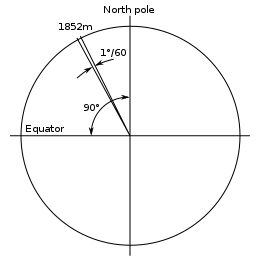Nautical mile
| Nautical mile | |
|---|---|
| Unit system | Non-SI unit |
| Unit of | Length |
| Symbol | M, NM, or nmi |
| Unit conversions | |
| 1 M, NM, or nmi in ... | ... is equal to ... |
| metre | 1852[1] |
| foot | ≈6076.12 |
| statute mile | ≈1.15078 |
| cable | 10 |


A nautical mile is a unit of measurement defined as exactly 1,852 metres (6,076.1 ft; 1.1508 mi). Historically, it was defined as one minute of latitude, which is equivalent to one sixtieth of a degree of latitude. Today, it is a non-SI unit[1] which has a continued use in both air and marine navigation,[2] and for the definition of territorial waters.[3]
One tenth of a nautical mile is a cable length.[4]
The derived unit of speed is the knot, defined as one nautical mile per hour.
Unit symbol
There is no internationally agreed symbol.[1]
- M is used as the abbreviation for the nautical mile by the International Hydrographic Organization[5] and by the International Bureau of Weights and Measures.[1]
- NM is used by the International Civil Aviation Organization.[6]
- nm (the SI symbol for the nanometre) is used by the U.S. National Oceanic and Atmospheric Administration.[7]
- nmi is used by the Institute of Electrical and Electronics Engineers[8] and the United States Government Publishing Office.[9]
While using M itself, the International Bureau of Weights and Measures recognises that NM, Nm and nmi are also in use.[1]
History
The word mile is from the Latin word for a thousand paces: mille passus. Navigation at sea was done by eye[10] until around 1500 when navigational instruments were developed and cartographers began using a coordinate system with parallels of latitude and meridians of longitude. In 1617 the Dutch scientist Willebrord Snell assessed the circumference of the Earth at 24,630 Roman miles (24,024 statute miles). Around that time British mathematician Edmund Gunter improved navigational tools including a new quadrant to determine latitude at sea. He reasoned that the lines of latitude could be used as the basis for a unit of measurement for distance and proposed the nautical mile as one minute or one-sixtieth (1/60) of one degree of latitude. As one degree is 1/360 of a circle, one minute of arc is 1/21600 of a circle (or, in radians, π/10800). These sexagesimal (base 60) units originated in Babylonian astronomy. Gunter used Snell's circumference to define a nautical mile as 6,080 feet, the length of one minute of arc at 48 degrees latitude. Since the earth is not a perfect sphere but is an oblate spheroid with slightly flattened poles, a minute of latitude is not constant, but about 1,861 metres (6,110 ft) at the poles and 1,843 metres (6,050 ft) at the Equator,[1] with a mean value of 1,852.3 metres (6,077 ft). Latitude and Longitude are equivalent or "square" at the Equator. Other countries measure the minute of arc at 45 degrees latitude, giving the nautical mile a length of 6,076 feet (1,852 m).[10]
In 1929, the international nautical mile was defined by the First International Extraordinary Hydrographic Conference in Monaco as precisely 1,852 metres.[1]
Imperial units and United States customary units used a definition of the nautical mile based on the Clarke (1866) Spheroid. The United States nautical mile was defined as 6,080.20 feet (1,853.24 m) based in the Mendenhall Order foot of 1893. It was abandoned in favour of the international nautical mile in 1954.[11]
The Imperial nautical mile, often called an Admiralty mile, or more correctly, an Admiralty measured mile, was defined by its relation to the Admiralty knot, 6,080 imperial feet per hour, so 1 imperial nautical mile is about 1,853.181 metres.[12] It was abandoned in 1970 and, legally, references to the obsolete unit are now converted to 1,853 metres.[13]
Despite the existence of precise modern definitions, in the early 21st century the old definitions are still in use. The Royal Yachting Association says in its manual for day skippers: "1 (minute) of Latitude = 1 sea mile", followed by "For most practical purposes distance is measured from the latitude scale, assuming that one minute of latitude equals one nautical mile".[14]
See also
References
- 1 2 3 4 5 6 7 Göbel, E.; Mills, I.M.; Wallard, Andrew, eds. (2006). The International System of Units (SI) (PDF) (in English from French original) (8th ed.). Paris: Bureau International des Poids et Mesures. p. 127. ISBN 92-822-2213-6. Retrieved 2017-06-20.
- ↑ "mile | unit of measurement". Encyclopædia Britannica. Retrieved 2016-06-10.
- ↑ "UNITED NATIONS CONVENTION ON THE LAW OF THE SEA". www.un.org. Retrieved 2016-06-10.
- ↑ Fenna, Donald (2002), "cable, cable length, cable's length", A Dictionary of Weights, Measures, and Units, Oxford: Oxford University Press, pp. 35, ISBN 0-19-860522-6, OCLC 62608533, retrieved 12 January 2017 . Also "fathom", from the same work (pp. 88–89, retrieved 12 January 2017).
- ↑ Symbols, Abbreviations and Terms used on Charts (PDF) (6 ed.). International Hydrographic Organization. 2016. Retrieved 2016-06-09.
- ↑ "WS SIGMET Quick Reference Guide" (PDF). ICAO. ICAO. Retrieved 2016-06-09.
- ↑ "Law of the Sea". NOAA. Retrieved 2016-06-09.
- ↑ "APPENDIX A: SYMBOLS AND PREFIXES". IEEE. Retrieved 2016-06-09.
- ↑ "U.S. Government Printing Office Style Manual". U.S. Government Printing Office. Retrieved 2016-06-10.
- 1 2 "Mile, Nautical and Statute – FREE Mile, Nautical and Statute information | Encyclopedia.com: Find Mile, Nautical and Statute research". www.encyclopedia.com. Retrieved 2016-06-10.
- ↑ Astin, A.V.; Karo, H. Arnold (June 25, 1959). "Refinement of values for the yard and the pound" (PDF). NOAA. National Bureau of Standards. Retrieved 2018-07-07.
- ↑ "imperial nautical mile". sizes.com. Retrieved 2016-06-10.
- ↑ "The Units of Measurement Regulations 1995". www.legislation.gov.uk. Retrieved 2016-06-10.
- ↑ Hopkinson, Sara (2012). RYA day skipper handbook - sail. Hamble: The Royal Yachting Association. p. 76. ISBN 9781-9051-04949.